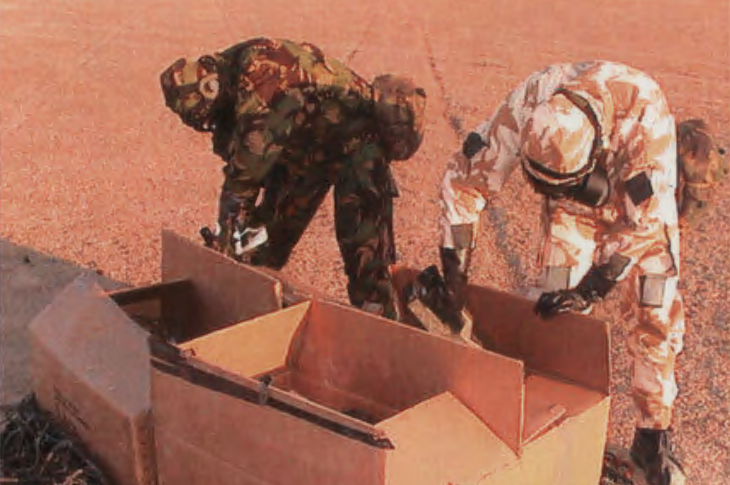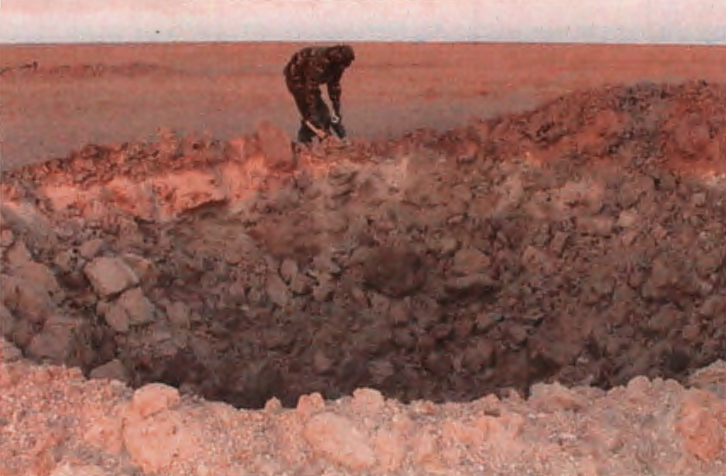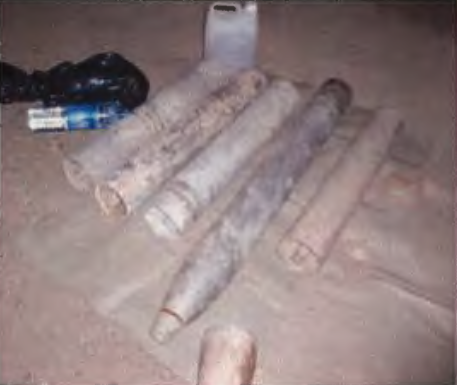British assisted destruction of Saddam Hussein's sarin chemical weapons in Iraq

In Iraq on 5 May 2006 the British military received five canisters filled with what experts suspected was the deadly neurological toxin sarin from an Iraqi source. Then they blew it up in the desert.
Military reports detailing Operation Bedouin II and Operation Bedouin earlier that year show that, like the CIA, the British military was destroying parts of Saddam Hussein's old chemical weapons stockpile. During the occupation of Iraq, Iraqis and others were moving these weapons about the country for potential sale to terrorists on the black market.
Details of these operations were revealed in documents published online last week (10 August 2015) by the UK's Ministry of Defence in response to a Freedom of Information request.
According to the Operation Bedouin II report, in May 2006, an Iraqi Security Forces source handed over five canisters that were once the payloads of Al Borak rockets in a padded cardboard box. The canisters were suspected to contain chemical weapons material as they met the profile of sarin-filled warheads.
Similar canisters found by the CIA between 2005 and 2006 contained sarin. The canisters were delivered to a Chemical, biological, radiological and nuclear defence unit (CBRN) stationed in the south-eastern Iraqi province of Maysan, bordering Iran. Britain's only permanent base in the area was Camp Abu Naji. The unit soon destroyed the suspected chemical weapons with explosives in the desert.
Earlier that year on 14 January the Maysan province Joint Operations Centre received a tip-off. Iraqi police had arrested two men seen unloading canisters that met the sarin munitions profile from the back of a truck into a house in Al Amarah, roughly 77.2km from the Iranian border.
Initial reports suggested the men had 70 canisters. "This number later reduced to 36, but eventually only 16 were recovered from the Iraqi Police Service station," reads the British military report. "It is uncertain whether the initial reports were inaccurate or some canisters were removed before Multi-National Force secured the remainder".
A team from Camp Abu Naji identified the payloads as 122mm canisters from Al Borak rockets "similar to those destroyed during previous iterations of" an unnamed operation "and therefore possibly containing a GB (Sarin) fill".
The team placed the canisters in a leak-seal package and, during what became known as Operation Bedouin, moved them to a destruction site that was used for another operation that's name has been redacted from the report. The canisters were destroyed with a controlled explosion as the CBRN team stood about 2,000 meters away.
When the unit returned to the site to confirm destruction of the weapons, they detected a very low vapour concentration of an agent used in sarin weapons.

These weapons were largely old chemical warheads and shells that were stockpiled by Saddam Hussein's Baathist government during the 1980 to 1988 Iran-Iraq war. At one point Iraq claimed to have produced 18,500 warheads, but later claimed to have destroyed these before the Gulf War.
Operation Bedouin II's report records the weapons were nearly empty and photos show they were in a rugged state. Yet even in low concentrations sarin can kill. If inhaled, in a matter of minutes it can suffocate its victims through lung paralysis. Sophisticated warheads mix the chemical's components while in flight since sarin degrades quickly in a matter of weeks to months.

Around the same time as the British recovered and destroyed the warheads, the CIA was carrying out its own plan to buy up and destroy Iraq's chemical weapons called Operation Avarice. An investigation published early this year in the New York Times revealed the US bought up 400 Al Borak rockets between 2005 and 2006. The intention was to ensure the components couldn't be used in improvised explosives by terrorists or militant groups, or leave the borders of Iraq.
The CIA had a source in south-east Iraq that they bought the old weapons from and they would fly there to make purchases. Many didn't contain the chemical, or simply contained a nonlethal liquid, but others were filled with sarin that was purer than experts estimated, considering the age of the weapons.
According to the New York Times report, the American military deemed the program a "nonproliferation success". The reports filed by the British military, however, indicate that some of the weapons may have eluded authorities.
The Bedouin II report indicates that the Iraqi Security Forces source who handed over five warheads for destruction originally intended "to hand over 16 canisters" and that information was received that "he may look to pass on several more canisters in the next few days".
Nevertheless, the UK's Ministry of Defence states that Operation Bedouin and Operation Bedouin II are the only two instances of chemical weapons destruction ever undertaken by the British military in Iraq.
© Copyright IBTimes 2025. All rights reserved.




















